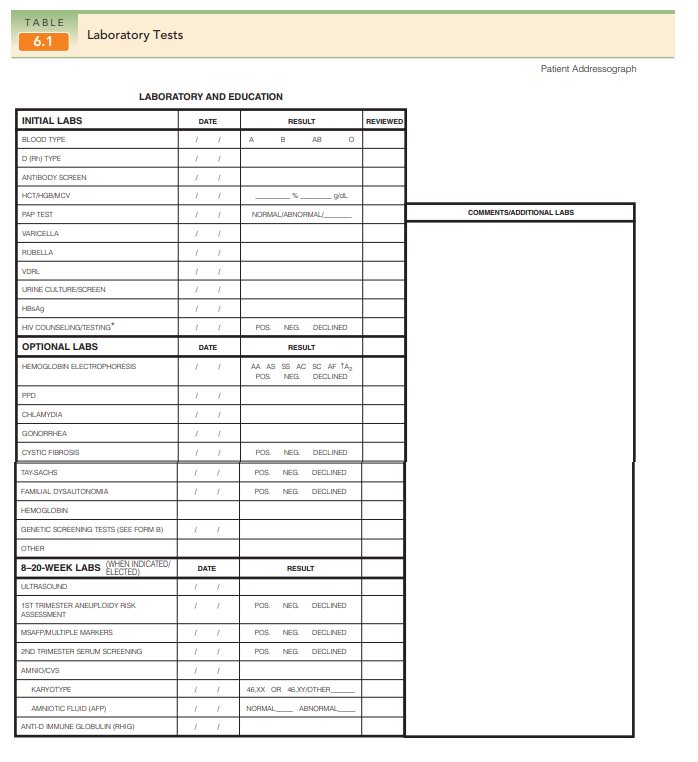Chapter: Obstetrics and Gynecology: Preconception and Antepartum Care
The Initial Prenatal Visit
THE INITIAL PRENATAL VISIT
At the initial prenatal
appointment, a comprehensive his-tory is taken, focusing on past pregnancies,
gynecologic history, medical history with attention to chronic medical issues
and infections, information pertinent to genetic screening, and information
about the course of the current pregnancy. A complete physical examination is
performed, including breast and pelvic examinations, as well as routine first
trimester laboratory studies (Table 6.1). Other studies may be performed as
indicated. The patient is given instruc-tions concerning routine prenatal care,
warning signs of complications, whom to contact with questions or problems, and
nutritional and social service information.


The initial obstetric pelvic
examination also includes a description of the various diameters of the bony
pelvis, assessment of the cervix (including cervical length, consistency,
dilation, and effacement), and size (usually expressed in weeks), shape,
consistency (firm to soft), and mobility. When the uterus grows in size so that
it exits the pelvis, the fundal height in centimeters represents the
gestational age of the fetus from that time to about 36 weeks.
Risk Assessment
Risk assessment is an important
part of the initial antena-tal evaluation. Questions
about history and chronic medical con-ditions are important in order to
identify the pregnant woman who is at risk for complications and to initiate a
management plan at the appropriate time. In addition to understanding
themedical risks, it is important to understand each woman’s social
circumstances, some of which may place her at risk for both physical and
emotional complications. Patients should be questioned about the following
aspects of their lifestyle that could pose a risk and receive appropriate
counseling, if indicated:
· Nutrition
and weight-gain counseling
· Sexual
activity
· Exercise
· Smoking
· Environmental
and work hazards
· Tobacco
· Alcohol
· Illicit/recreational
drugs
· Domestic
violence
· Seat belt
use
Initial Assessment of Gestational Age:
Estimated Date of Delivery
Gestational age is the number of weeks that have
elapsed betweenthe first day of the last menstrual period (not the presumed
time of conception) and the date of delivery. Establishing
an accurateestimated gestational age and estimated
date of delivery(EDD) is an important part of the initial antepartum
visit.Issues such as prematurity and postterm pregnancy and their subsequent
management, as well as the timing of screening tests (i.e., maternal serum
screening for trisomy 21 and NTDs, assessment of fetal maturity) are affected
by the accuracy of gestational age.
Naegele’s
rule is an easy way to calculate the EDD:add 7 days to
the first day of the last normal menstrual flow and subtract 3 months. In a
patient with an idealized 28-day menstrual cycle, ovulation occurs on day 14;
therefore, the conception age of the pregnancy is actually 38 weeks. The use of
the first day of the last menstrual period as a start-ing point for gestational
age is standard, and gestational, not conceptional, age is used. “Normal”
pregnancy lasts 40 ±2 weeks,
calculated from the first day of the last nor-mal menses (menstrual or
gestational age).
To establish an accurate gestational age, the date of onset ofthe last normal menses is crucial.A light bleeding episodeshould not be mistaken for a normal menstrual period. A history of irregular periods or taking medications that alter cycle length (e.g., oral contraceptives, other hormonal preparations, and psychoactive medications) can confuse the menstrual history.
If sexual intercourse is infrequent or timed for
conception based on assisted reproductive tech-niques (ARTs), a patient may
know when conception is most likely to have occurred, thus facilitating an
accurate calculation of gestational age.
Obstetric ultrasound examination
is the most accurate measurement available in the determination of gestational
age. Pelvic examination by an experienced examiner is accu-rate, within 1 to 2
weeks, in determining gestational age until about 14 to 16 weeks, at which time
the lower uterine segment begins to form, thereby making clinical estimation of
gestational age less accurate. In addition, in women with a retroverted uterus,
estimation of gestational age is less accurate than in women with other
positions of the uterus.
Related Topics